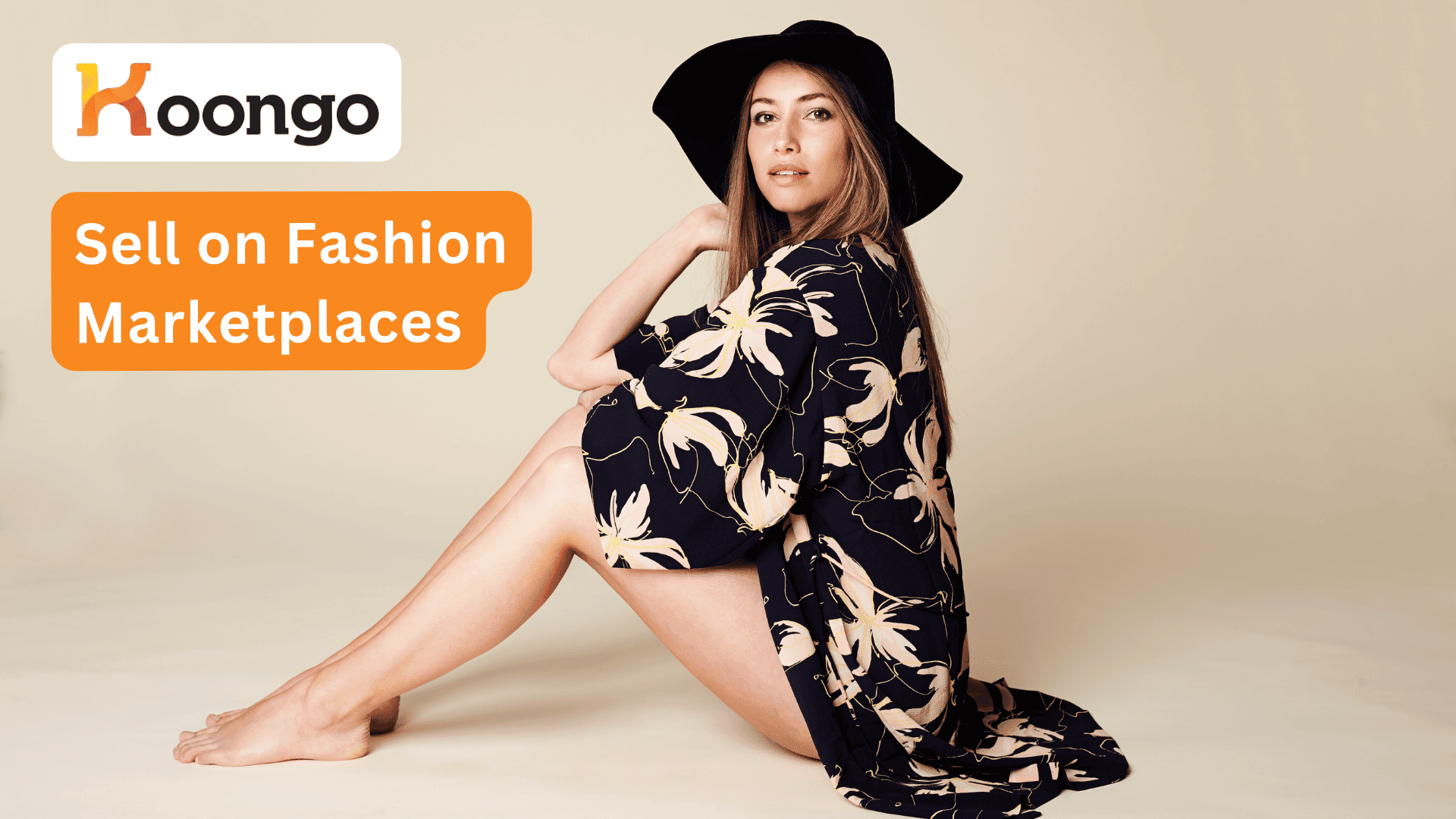The fashion industry is a dynamic and ever-evolving market that offers numerous opportunities for entrepreneurs and fashion enthusiasts to start their businesses. One popular avenue is to sell on fashion marketplaces. These platforms provide access to a global customer base, making it easier than ever to reach potential buyers and offer your designer clothes.
Many of Koongo’s clients reach different online fashion marketplaces where they can sell their fashion goods like clothing items or accessories. Fashion is one of the most researched industries on the web, and consumers are always ready to buy.
Koongo simplifies and automates listing and managing products on the fashion online marketplace. Within Koongo, you can effortlessly enhance your product information or choose particular products for your campaigns. Through seamless API integration, your data remains consistently current on those platforms. Koongo helps you reach a broader audience and increase your online sales presence.
Jump ahead to
- How to start selling clothes online fashion marketplace
- Why selling fashion with Koongo is beneficial?
- Koongo-supported online fashion marketplaces
- How can I start with a fashion marketplace integration?
Jump ahead to
How to start selling clothes online fashion marketplace

- Conduct Market Research – Before you dive into selling fashion on an online marketplace, it’s essential to conduct market research to understand the latest fashion trends, your target online shoppers’ preferences, and your competitors. Identifying gaps in the market can give you a competitive edge.
- Choose the Right Marketplace – The right fashion marketplace is crucial for success. Top online fashion marketplaces offer advantages such as convenience, a wide range of options, and opportunities for brand expansion. Consider factors such as the platform’s reach, fees, and policies. Popular online fashion marketplaces include Amazon, eBay, Zalando, Miinto, Yoox, Facebook Marketplace, Instagram, Pinterest, and Spartoo. Fashion brands can benefit from these platforms by reaching more consumers and utilizing enhanced selling tools. Independent brands have opportunities to showcase their unique products and benefit from extensive reach and resources. ASOS Marketplace is a prominent platform catering to independent brands and fashion retailers, offering a global reach and ease of getting started. Make sure the marketplace aligns with your target audience and brand.
- Develop a Brand Identity – Create a strong brand identity that resonates with your target customers. Choose a unique brand name, design a memorable logo, and craft a compelling tagline. Your brand identity should reflect your fashion niche and values. Offering exclusive collections can attract customers looking for unique items and special brand collaborations.
- Create High-Quality Listings – Your product listings are your storefront on the marketplace. Invest in high-quality photos that showcase your fashion items from different angles and provide clear product descriptions. Highlight essential details such as materials, sizing, and care instructions.
- Pricing Strategy – Set competitive prices for your clothing items while considering your production or sourcing costs and desired profit margin. Research what similar items are selling for on the marketplace to determine a competitive price range.
- Build Your Online Storefront – Create an appealing storefront or profile on the chosen marketplace. Customize it to reflect your brand’s aesthetics. Use banners, images, and product categorization to make navigation easy for potential customers.
- Optimize for Search – Improve your visibility within the marketplace by using relevant keywords in your product titles and descriptions. Utilize product tags and categories to ensure your items appear in relevant searches.
- Offer Exceptional Customer Service – Respond promptly to customer inquiries and provide accurate information. Handle returns and refunds professionally and promptly to build trust and customer loyalty.
- Shipping and Fulfillment – Choose reliable shipping options and clearly communicate shipping times to customers. Consider offering free shipping cost, prepaid shipping label, or competitive shipping rate options to attract more buyers.
- Marketing and Promotion – Promote your listings within the marketplace using sponsored listings or advertising options. Leverage social media platforms and email marketing to drive traffic to your marketplace store. Collaborate with fashion influencers or bloggers for reviews and promotions.
- Monitor Performance – Track your sales, sold items, customer feedback, and reviews. Use this data to adjust your strategies. Identify which products are selling well and which ones need improvement.
- Expand Your Product Line – Gradually expand your fashion offerings based on market demand and customer feedback. Stay updated on emerging fashion trends and incorporate them into your inventory.
- Compliance and Legal Considerations – Ensure your business complies with all relevant laws and regulations, including tax requirements, intellectual property rights, and consumer protection laws.
- Customer Feedback and Improvement – Listen to customer feedback and continuously improve your products and services. Building a loyal customer base relies on delivering quality and value consistently.
- Scale Your Business – As your business grows, consider scaling by expanding to another online marketplace or launching your fashion ecommerce website.
Selling fashion on an online marketplace can be a rewarding venture when approached strategically. By following these steps and staying committed to providing quality products and exceptional customer service, you can build a successful fashion business in the competitive online marketplace landscape.
Why selling fashion with Koongo is beneficial?

Koongo allows you to synchronize your product data and marketplace orders for dedicated online fashion marketplaces. As a leading online marketplace solution, it offers several benefits to online retailers and e-commerce businesses looking to expand their reach, simplify selling process and improve their selling processes on top fashion marketplaces.
Here are some of the key benefits of using Koongo:
- Multi-Channel Selling: Koongo can connect your online store to multiple marketplaces, comparison shopping engines, and affiliate networks simultaneously. This means you can reach a broader audience without manual management of each platform.
- Automated Data Feed Generation: Koongo generates high-quality product feeds for each connected marketplace or channel, ensuring that your product information, including titles, descriptions, prices, and images, meets the specific requirements of each platform.
- Inventory Management: Koongo automates inventory synchronization across all connected marketplaces. This prevents overselling and ensures that product availability is accurate and up-to-date across all channels.
- Dynamic Pricing: The platform offers dynamic pricing capabilities, allowing you to adjust your marketplace offers based on factors such as competition, demand, or profit margins. This feature helps you stay competitive and maximize profits.
- Scheduled Updates: You can schedule product listings, pricing, and inventory updates. This ensures that your product data is always current and eliminates the need for manual updates.
- Ease of Expansion: As your business grows, you can easily expand to new marketplaces and channels by connecting them through Koongo. This simplifies the process of reaching new audiences and scaling your e-commerce operations.
- Customizable Feeds: Koongo offers customization options for product feeds, allowing you to tailor your data to each marketplace’s requirements. You can optimize product titles, descriptions, and attributes for better visibility and performance.
- Integration with E-commerce Platforms: Koongo integrates seamlessly with various e-commerce platforms, including WooCommerce, Magento, Shopify, BigCommerce, Wix, Shopware, Lightspeed, and others. This makes it accessible to a wide range of online retailers.
- Time and Resource Savings: By automating many tasks related to multi-channel selling, Koongo saves you time and resources that can be redirected toward other aspects of your business, such as marketing and customer service.
- Improved Customer Experience: Accurate and up-to-date product information, inventory, and pricing on all channels contribute to a better customer experience and help build trust with your customers.
- Compliance Management: Koongo helps you stay compliant with the policies and requirements of each marketplace by automatically adjusting your product data as needed, reducing the risk of listing violations.
- Continuous Support: The platform typically provides customer support and training resources to assist you in getting the most out of its features and capabilities.
Overall, Koongo simplifies the complexities of multi-channel e-commerce and allows businesses to expand their online presence efficiently while maintaining accurate and up-to-date product information across various marketplaces and channels. This can lead to increased sales, improved customer satisfaction, and greater operational efficiency.
Koongo-supported online fashion marketplaces

Koongo helps online retailers expand their reach by listing and selling products on top online fashion marketplaces and comparison shopping engines. Many of those marketplaces are focused on fashion. Here, you can check the leading fashion marketplaces supported by Koongo.
Zalando
Zalando was founded in 2008 in Berlin as a leading online marketplace for shoes. By 2010, it had become a market leader in online shoe sales and had incorporated various fashion items into its platform. Zalando is the leading European online retailer of shoes, fashion, and beauty products, with over 50 million active users in 25 European markets. Koongo supports Zalando Partner Program and Zalando Connected Retail to sell clothes and accessories. Sell your high quality items on Zalando.
Zalando’s main features:
- Available in 23 countries
- Over 430 million views per month
- Over 34 million active customers
Miinto
Miinto is an online fashion platform created for all fashion consumers and fashion brands who demand the same high level of service and personal experience online that they would expect to shop at their local physical stores. The Miinto concept is based on a collaboration with shop owners and brands, allowing them to go online and drastically expand their market while benefiting from Miinto’s marketing, digital, and technical expertise. Sell clothes online with Miinto!
Miinto’s main features:
- Available in 6 European countries
- Over 2.000 retailers
- 100.000+ Products in total
Spartoo
Spartoo global fashion group is one of the leading online fashion retailers in Europe, with more than 3 million customers across Europe. More than 2000 brands and 100,000 styles of shoes, clothes, and bags are available. Spartoo is active in 15 countries: France, UK, Spain, Italy, the Netherlands, Sweden, Denmark, Finland, Belgium, Greece, Poland, Portugal, the Czech Republic, Austria, and Germany.
Spartoo’s main features:
- Active in 19 countries
- 14 Million unique monthly visitors
- 3.800 Brands
The Vintage Bar
The Vintage Bar is a community-driven fashion marketplace based on buying, selling, and providing inspiration, all within premium and luxury vintage items, including exclusive collections. The platform is based on a clear mission: To show that vintage clothing can be as cool and exciting as new items by connecting buyers and sellers worldwide. Visual inspiration and inclusion are two of The Vintage Bar’s core values. By creating an inclusive and relatable social hangout, The Vintage Bar invites their growing community of sellers and buyers to partake in more circularly and sustainable fashion.
TVB’s main features:
- Best pre-owned items in premium & luxury fashion
- High-end marketplace
- Worldwide shipping
Yoox
Established in 2000, YOOX is the world’s leading online fashion, design, and art store, renowned for its exclusive collections that last a lifetime and beyond. YOOX offers a never-ending selection of products, including an edited range of hard-to-find clothing and accessories from the world’s most prestigious designers, exclusive capsule collections, eco-friendly fashion; a unique assortment of home design objects, rare vintage finds, and books; and a curated selection of compelling and collectible artworks chosen by international curators and critics from the world’s leading galleries and institutions. YOOX is one of the great places to sell clothes online.
Yoox’s main features:
- Available in more than 25 countries in the EU
- More than 5.3 million customers
- Option to buy tailor-made visibility projects
Glami
Glami is a search engine for all things fashion that inspires everyone, created to make fashion discovery and shopping a pleasurable experience for fashion brands and consumers alike. This fashion marketplace brings offers from different e-shops and has over 2 million products in the database. It inspires shoppers in the Czech Republic, Slovakia, Romania, Hungary, France, Germany, Russia, Greece, Turkey, and Bulgaria, and it’s expanding fast to even more countries.
Glami’s main features:
- Active in 15 countries
- 40 million monthly visitors and fashion lovers
- 350 000 orders for e-shops each month
Modivo
Modivo is a leading online marketplace and a European leader in online sales of clothes, footwear and accessories. It combines the offers of e-commerce platforms eobuwie.pl and MODIVO. Thanks to investments in modern technology and the innovative esize.me project, the Company achieves a real integration of online and offline sales channels.
Modivo’s main features:
- Presence in 20 European markets
- European leader in online sales of clothes, footwear and accessories
- Hundreds of top brands
Amazon
In the beginning, Amazon sold books. Today, Amazon is a leading online marketplace and a titan of e-commerce, logistics, payments, luxury items, hardware, home decor, designer items, data storage, fashion items, and media. It dabbles in plenty of more industries. It’s the go-to site for online shoppers and merchants alike, a modern necessity that independent sellers love to have.
Amazon’s main features:
- Vast and diverse customer base
- Fulfillment by Amazon (FBA) option
- Various advertising and promotional tools
eBay
eBay is a leading online marketplace founded in 1995. It enables people and businesses to buy and sell a wide range of products, either through auctions or fixed-price listings. has a global presence, seller ratings, and offers tools like eBay Stores for customization. It also has sections like eBay Motors for automotive-related items. The platform has evolved and is known for its mobile apps, PayPal integration (though this has changed over time), and eBay Partner Network. eBay promotes corporate responsibility and sustainability.
eBay’s main features:
- Vast global customer base
- Provides sellers with flexibility in terms of listing formats
- Seller protection programs and dispute resolution services
Facebook Marketplace
Facebook Marketplace is a leading online marketplace integrated with the social network, where users can buy, sell, and trade various items with people in their local communities. It allows individuals and businesses to list products, communicate with potential buyers or sellers, and arrange in-person transactions. Facebook Marketplace is a convenient way to discover local deals, including items like furniture, electronics, clothing, and more. Users can access it through the Facebook app or website, making it easy to connect with nearby buyers and sellers.
Facebook Marketplace’s main features:
- Over 2.8 billion monthly active users
- Easy listing and communication
- Social trust and transparency
Sellers can use Instagram, a leading online marketplace, to sell products directly to customers. It involves visual posts, product tagging, shoppable posts, and features like Instagram Shops and live shopping. Sellers can collaborate with influencers and use advertising.
Instagram’s main features:
- Ideal for showcasing products and telling your brand’s story
- Direct shopping features – integrated shopping features
- Engaged user base – over a billion monthly active users
Sellers can use Pinterest, a leading online marketplace, to showcase and sell products through Product Pins, Shop tabs, Buyable Pins, and advertising. It leverages Pinterest’s visual focus for effective product promotion.
Pinterest’s main features:
- Visual discovery platform – showcase your products through visually appealing pins
- High purchase intent – users actively seek ideas and products to purchase
- Linking to e-commerce – link your pins directly to your ecommerce websites
For more information about all Koongo-supported fashion online marketplaces, please check Koongo fashion marketplaces list.
How can I start with a fashion marketplace integration?
Start your 30-day free trial of Koongo and upload your product data. Then, follow an online marketplace guide and set up the channel integration. If you have any questions, please email support@koongo.com.
We are here to support you every step of the way, ensuring that your experience with Koongo is always great.perience with Koongo is always great.
Continue reading →
 EN
EN 
